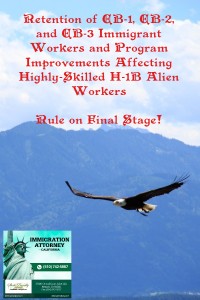Comments Period Completed on the long Awaiting Rule for I-140 – Now on Final Stage!
The rule “Retention of EB-1, EB-2, and EB-3 Immigrant Workers and Program Improvements Affecting Highly-Skilled H-1B Alien Workers” has now reached its final stage. Let us hope we will see some breakthrough on this one.
| DHS/USCIS | Final Rule Stage | Retention of EB-1, EB-2, and EB-3 Immigrant Workers and Program Improvements Affecting Highly-Skilled H-1B Alien Workers | 1615-AC05 |
Here is a Summary of the regulation proposed.
Retention of EB-1, EB-2, and EB-3 Immigrant Workers and Program Improvements Affecting High-Skilled Nonimmigrant Workers
Retention of EB-1, EB-2, and EB-3 Immigrant Workers and Program Improvements Affecting High-Skilled Nonimmigrant Workers
Summary of Proposed Rule
On December 31, 2015, the Department of Homeland Security (DHS) released a Proposed Rule (80 FR 81899) for public comment, entitled Retention of EB-1, EB-2, and EB-3 Immigrant Workers and Program  Improvements Affecting High-Skilled Nonimmigrant Workers. Many of these changes are primarily aimed at improving the ability of U.S. employers to hire and retain high-skilled workers who are beneficiaries of approved employment-based immigrant visa petitions and are waiting to become lawful permanent residents (LPRs), while increasing the ability of such workers to seek promotions, accept lateral positions with current employers, change employers, or pursue other employment options.
Improvements Affecting High-Skilled Nonimmigrant Workers. Many of these changes are primarily aimed at improving the ability of U.S. employers to hire and retain high-skilled workers who are beneficiaries of approved employment-based immigrant visa petitions and are waiting to become lawful permanent residents (LPRs), while increasing the ability of such workers to seek promotions, accept lateral positions with current employers, change employers, or pursue other employment options.
Retention of employment-based immigrant visa petitions: DHS proposes to amend its automatic revocation regulations so that immigrant visa petitions that have been approved for 180 days or more would no longer be subject to automatic revocation based solely on withdrawal by the petitioner or termination of the petitioner’s business. As long as the petition approval has not been revoked for fraud, material misrepresentation, the invalidation or revocation of a labor certification, or USCIS error, the petition will generally continue to be valid to the beneficiary for various job portability and status extension purposes. The beneficiary, however, must obtain a new job offer and may need another immigrant visa petition approved to adjust status.
Retention of priority dates: Priority date retention for EB-1, EB-2 and EB-2 immigrant visa petitions will generally be available so long as the initial immigrant visa petition was approved and not revoked for fraud, material misrepresentation, the invalidation or revocation of a labor certification, or USCIS error.
Nonimmigrant grace periods: DHS proposes to establish a one-time grace period of up to 60 days whenever employment ends for individuals holding E-1, E-2, E-3, H-1B, H1-B1, L-1 or TN nonimmigrant status. The individual may not work during the grace period.
Eligibility for employment authorization for beneficiaries in compelling circumstances. DHS also proposes to provide additional stability and flexibility to certain high-skilled nonimmigrant workers in the United States who are the beneficiaries of approved employment-based immigrant visa petitions (the workers) but who cannot obtain an immigrant visa number due to statutory limits on immigrant visa issuance and are experiencing compelling circumstances. Specifically, DHS proposes to allow such beneficiaries in the United States on E-3, H-1B, H-1B1, L-1, or O-1 nonimmigrant status to apply for separate employment authorization for a limited period if there are compelling circumstances that, in the discretionary determination of DHS, justify the consideration of such employment authorization
H-1B licensing: DHS proposes allowing an unlicensed worker to meet the licensure requirement by demonstrating that the worker has filed a request for a license but is unable to obtain it because a state or locality requires a SSN or the issuance of employment authorization before accepting or approving such requests. Alternatively, a petition for an unlicensed worker will be approved where the state allows such individuals to be employed in the occupation under the supervision of a licensed or supervisory personnel.
Employment authorization extension: DHS proposes to automatically extend employment authorization and validity of existing EADs for up to 180 days from the date of expiration so long as:
-
A renewal application is filed based on same employment authorization category;
-
The application is timely filed before the EAD expires; and
-
Eligibility for employment authorization continues beyond expiration of EAD and an independent adjudication of underlying eligibility is not a prerequisite.
At the same time, DHS is proposing to eliminate the regulatory provision requiring EAD applications to be processed within 90 days.
DHS proposes to extend employment authorization to a discrete subset of high-skilled workers (E-3, H-1B, H-1B1, O-1 or L-1 nonimmigrants) for one year if:
-
The individual is the beneficiary of an approved immigrant visa petition under the EB-1, EB-2 or EB-3 classification;
-
The individual does not have an immigrant visa immediately available; and
-
The individual can demonstrate compelling circumstances that justify an independent grant of employment authorization.
DHS has currently identified four (4) circumstances in which it may consider granting employment authorization under the proposed change:
-
Serious illnesses and disabilities;
-
Employer retaliation;
-
Other substantial harm to the applicant; and
-
Significant disruption to the employer
DHS is proposing to limit renewal of such employment authorization to those workers who can show that they continue to be the principal beneficiary of an approved EB-1, EB-2 or EB-3 immigrant visa petition and either: (1) the worker continues to face compelling circumstances; or (2) the worker has a priority date that is less than one year from the current cut-off date for the relevant employment-based category and country of nationality in the most recent visa bulletin.
DHS proposes that in all cases, an individual is not eligible for employment authorization if convicted of any felony or two (2) or more misdemeanors.
DHS is proposing that the expired EAD, in combination with a I-797C indicating timely filing would be considered an unexpired EAD for purposes of I-9 requirements.
The following fifteen (15) employment authorization categories are eligible to receive automatic extensions under this proposed rule:
-
Aliens admitted as refugees;
-
Aliens granted asylum;
-
Aliens admitted as parents or dependent children of aliens granted permanent residence;
-
Aliens admitted as citizens of the Federated States of Micronesia or the Marshall Islands;
-
Aliens granted withholding of deportation or removal;
-
Aliens granted TPS;
-
Aliens who have properly filed TPS applications and are prima facie eligible;
-
Aliens who have properly filed applications for asylum or withholding of deportation or removal;
-
Aliens who have filed applications for adjustment of status;
-
Aliens who have filed applications for suspension of deportation or cancellation of removal;
-
Aliens who have filed applications for creation of record of lawful admission for permanent residence;
-
Aliens who have properly filed legalization applications pursuant to section 210;
-
Aliens who have properly filed legalization applications pursuant to section 245A;
-
Aliens who have filed applications for adjustment of status pursuant to section 1104 of the LIFE Act; and
-
Aliens who are the principal beneficiaries or qualified children of approved VAWA self-petitioners.
H-1B extension for individuals affected by the per-country limitations: DHS proposes that the H-1B maximum six (6) year exemption be granted in three (3) year increments until the beneficiary can adjust status. The proposed rule enables individuals to remain in H-1B status until they are able to receive an immigrant visa and clarifies that even though it is described as a “one-time protection,” the exemption remains available until after the beneficiary has an EB-1, EB-2, or EB-3 immigrant visa number immediately available. DHS also proposes to allow the H-1B petitioner to file for an extension under section 106(b) with respect to any qualifying labor certification application or employment-based immigrant visa petition, pursuant to section 106(a) of AC21.
DHS also proposes to conform regulations by requiring the H-1B employer to file an H-1B petition demonstrating that the beneficiary has previously held H-1B status and that 365 days has elapsed or will have elapsed between: (1) the filing of an application for labor certification or an employment-based immigrant visa petition on behalf of the individual; and (2) the date on which the individual reached or will reach the six (6) year limitation on H-1B admission.
Under the proposed rule, a denial or revocation would not be considered final by USCIS during the period authorized to file an administrative appeal or during the period during which an appeal is pending.
The rule generally requires that to remain eligible for extensions of H-1B status, the individual must file an application for adjustment of status or submit an application for an immigrant visa within one (1) year of an immigrant visa becoming immediately available. Moreover, if the accrual of the one (1) year period is interrupted by the retrogression of previously available immigrant visas, the individual would be permitted a full new one (1) year period to seek LPR status when immigrant visas become available again.
Adjustment of status: DHS proposes to expand the treatment of beneficiaries who have applications for adjustment of status that have been pending for at least 180 days to those in which the petitioner’s business terminates after the application for adjustment of status has been pending for at least 180 days. Under the proposed rule, the beneficiary would not be required to have a new immigrant visa petition filed on his or her behalf, and instead would be required to demonstrate that he or she has a new offer of employment in a same or similar occupational classification.
The proposed regulatory provision accordingly defines “same occupational classification” as an occupation that resembles in every relevant aspect the occupation for which the underlying employment-based immigrant visa petition was approved.
The term “similar occupational classification” is defined as an occupation that shares essential qualities or has a marked resemblance or likeness with the occupation for which the underlying employment-based immigrant visa petition was approved.
Employers not subject to H-1B numerical limitations: Under the proposed rule, an H-1B petitioner that is not itself a qualifying institution, organization or entity may claim an exemption from the cap for an H-1B nonimmigrant worker employed at such organization or entity if:
-
The majority of the worker’s duties will be performed at a qualifying institution, organization or entity; and
-
Such job duties directly and predominantly further the essential purpose, mission, objectives or functions of the qualifying institution, organization or entity.
To better account for such relationships, DHS proposes to expand on the current definition to include nonprofit entities that have entered into formal written affiliation agreements with institutions of higher education and are able to meet two (2) additional criteria:
-
Such entities must establish an active working relationship for the purposes of research or education; and
-
One of their primary purposes is to directly contribute to the research or education mission of the institution of higher education
Retention of priority dates: DHS proposes to revise its regulations to clarify that the priority date of any properly filed employment-based immigrant visa petition that does not require a labor certification will be the date the completed, signed petition is properly filed with DHS.
DHS proposes that the priority dates of EB-1, EB-2, and EB-3 petitions may be used for subsequently filed EB-1, EB-2 and EB-3 petitions unless USCIS denies the petition or revokes the petition due to fraud, USCIS error, or revocation of the labor certification.
Amendments to forms: Additionally, should these rules take effect, there will be various changes to USCIS forms. DHS proposes that Form I-765, Application for Employment Authorization, include yes/no questions requiring applicants to disclose certain criminal convictions. DHS also proposes that Form I-140, Immigrant Petition for Alien Worker, remove instructions regarding a duplicate 9089, as USCIS no longer requires uncertified ETA 9089 to be submitted in duplicate. Form I-129, Petition for a Nonimmigrant Worker, may also undergo revisions regarding the H-1B Data Collection and Filing Fee Exemption Supplement. Finally, Form I-485, Application to Register Permanent Residence or Adjust Status, may also include a new Supplement J to allow adjustment applicant requesting portability to provide formal attestations regarding important aspects of the job offer.
H1 Extension under AC21 regardless of Current Status H1B AC21 extensions should be available whether the worker is in/out USA at the time of filing the extension.
60 Day H-1B Grace Period Nonimmigrants in E-1, E-2, E-3, H-1B, H-1B1, L-1, or TN would be granted a grace period of up to 10 days before and after their validity period and a one-time grace period, of up to 60 days or until the end of their authorized validity period, whichever is shorter. This applies to for E-1, E-2, E-3, H-1B, H-1B1, L-1, or TN status thus providing both an additional 10 days to enter the U.S. before his or her start date and leave 60 days after early termination by beneficiary or employer. Indeed, all the above visa categories, including H-1B, will have a one-time, up to 60-days grace period to look for another job and apply again or apply for change of status to another category without having to leave the U.S. You can stay in the U.S., but cannot work during this time.
Delay in filing I 485 can impact H1B extension under AC21 Eligibility for extension beyond 6 year of H1B requires that the applicant did not fail to file I 485 within one year of his/her priority date becoming current under the Visa Bulletin.

